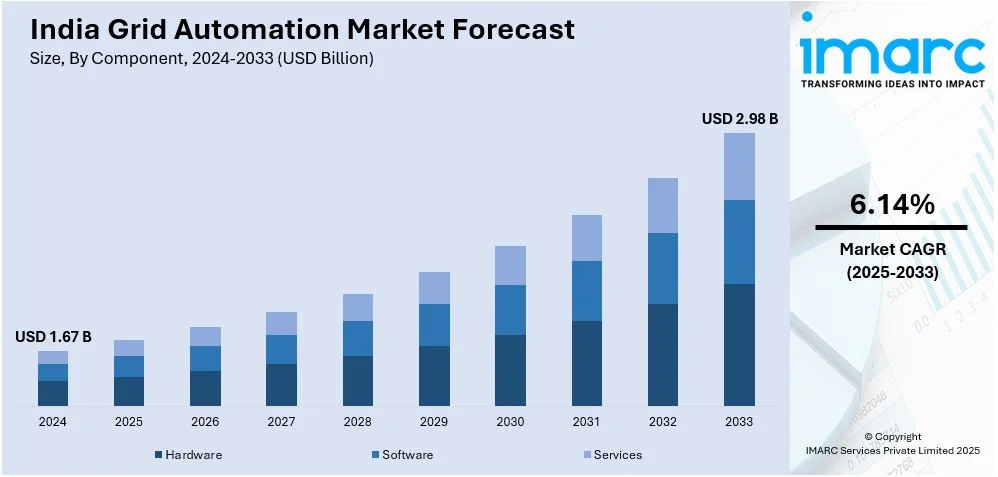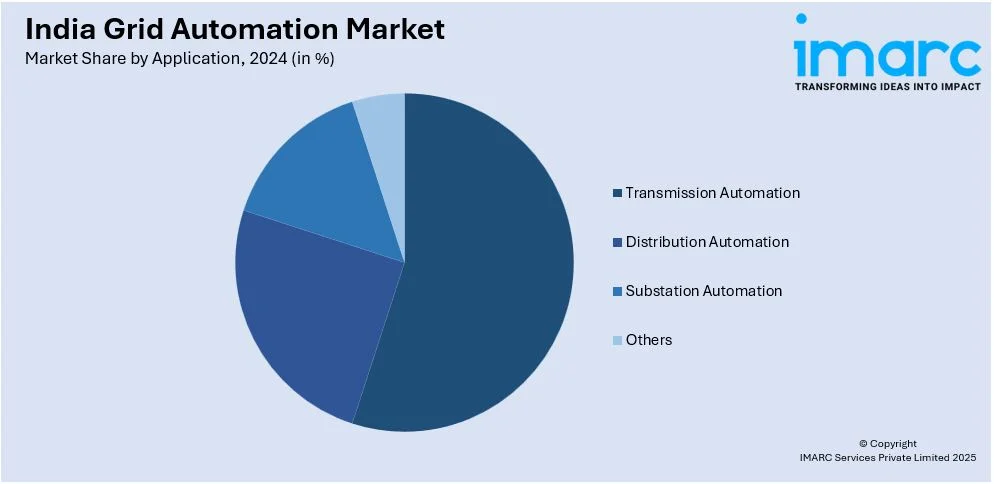
India Grid Automation Market Size, Share, Trends and Forecast by Component, Application, End User, and Region, 2025-2033
India Grid Automation Market Overview:
The India grid automation market size reached USD 1.67 Billion in 2024. Looking forward, IMARC Group expects the market to reach USD 2.98 Billion by 2033, exhibiting a growth rate (CAGR) of 6.14% during 2025-2033. The growth is spurred by the integration of increasing renewable energy, smart grid technologies adoption, and artificial intelligence (AI) and Internet of Things (IoT) developments for predictive maintenance. Support from the government in the form of the renewed distribution sector scheme (RDSS) and Green Energy Corridor further propels modernization drives, improving the reliability, efficiency, and security of the grid as well as lowering operational costs.
|
Report Attribute
|
Key Statistics
|
|---|---|
|
Base Year
|
2024 |
|
Forecast Years
|
2025-2033
|
|
Historical Years
|
2019-2024
|
| Market Size in 2024 | USD 1.67 Billion |
| Market Forecast in 2033 | USD 2.98 Billion |
| Market Growth Rate 2025-2033 | 6.14% |
India Grid Automation Market Trends:
Rising Integration of Renewable Energy
India’s shift toward renewable energy is accelerating demand for grid automation solutions. As of October 2024, the country’s renewable energy-based electricity generation capacity reached 201.45 GW, accounting for 46.3% of total installed capacity. The rapid expansion of solar and wind power is driving the adoption of automation technologies to ensure grid stability and optimize power distribution. Advanced sensors, AI, and real-time data analytics are improving grid stability by anticipating ups and downs in energy supply. Automated substations and smart inverters are significant in connecting renewables to the national grid. State policies such as the Green Energy Corridor project are also increasing investments in automation. The greater demand for real-time monitoring and quick response schemes is rendering automated grid infrastructure unavoidable for effectively tackling the intricacies of renewable integration.

To get more information on this market, Request Sample
Adoption of AI and IoT in Grid Management
AI and Internet of Things (IoT) are revolutionizing India grid automation space by making predictive maintenance, fault detection, and grid self-healing mechanisms a reality. AI-powered analytics are assisting utilities in predicting equipment breakdowns, optimizing energy delivery, and improving demand forecasting. IoT-based devices like smart transformers and auto-reclosers are allowing real-time grid monitoring and reaction to voltage fluctuations. With the incorporation of machine learning (ML) algorithms in automation systems, grid resilience is enhanced and manual interventions minimized. Moreover, AI-based cybersecurity systems are being deployed to safeguard grid networks against cyber risks. With greater digitalization, AI and IoT are assuming a central position in making India's power grid more efficient, secure, and responsive.
Expansion of Smart Grid Technologies
India is rapidly transitioning toward smart grids to modernize power distribution networks. The Revamped Distribution Sector Scheme (RDSS), launched in 2022 with an outlay of INR 3.03 trillion (USD 36.8 billion), is accelerating this shift by funding infrastructure upgrades, including the installation of 250 million smart meters by 2025. Utilities are deploying automated metering infrastructure (AMI), SCADA systems, and distributed energy resource management (DERM) solutions to enhance operational efficiency. The adoption of digital substations and predictive maintenance analytics is minimizing downtime and enhancing power quality. Sophisticated communication networks, such as IoT-capable sensors, allow for real-time decision-making. As power demand increases, grid automation is guaranteeing improved reliability, optimal energy management, and minimized transmission losses, and thus modernized infrastructure is imperative to India's changing energy landscape.
India Grid Automation Market Segmentation:
IMARC Group provides an analysis of the key trends in each segment of the market, along with forecasts at the region level for 2025-2033. Our report has categorized the market based on component, application and end user.
Component Insights:
- Hardware
- Sensors
- Programmable Logic Controllers (PLCs)
- Remote Terminal Units (RTUs)
- Communication Networks
- Software
- Supervisory Control and Data Acquisition (SCADA)
- Distribution Management Systems (DMS)
- Advanced Metering Infrastructure (AMI)
- Grid Optimization Software
- Services
- Installation and Integration
- Maintenance and Support
- Consulting and Training
The report has provided a detailed breakup and analysis of the market based on the type. This includes hardware (sensors, programmable logic controllers (PLCS), remote terminal units (RTUS), and communication networks), software, (supervisory control and data acquisition (SCADA), distribution management systems (DMS), advanced metering infrastructure (AMI), and grid optimization software), and services (installation and integration, maintenance and support, and consulting and training).
Application Insights:

- Transmission Automation
- Distribution Automation
- Substation Automation
- Others
A detailed breakup and analysis of the market based on the application have also been provided in the report. This includes transmission automation, distribution automation, substation automation, and others.
End User Insights:
- Utilities
- Industrial
- Commercial
- Residential
The report has provided a detailed breakup and analysis of the market based on the end user. This includes utilities, industrial, commercial, and residential.
Regional Insights:
- North India
- South India
- East India
- West India
The report has also provided a comprehensive analysis of all the major regional markets, which include North, South, East, and West India.
Competitive Landscape:
The market research report has also provided a comprehensive analysis of the competitive landscape. Competitive analysis such as market structure, key player positioning, top winning strategies, competitive dashboard, and company evaluation quadrant has been covered in the report. Also, detailed profiles of all major companies have been provided.
India Grid Automation Market News:
- In March 2025, PURE launched PuREPower, a new energy storage solution for homes, businesses, and the grid, supporting India’s clean energy transition. The range includes PuREPower Home, PuREPower Commercial, and the upcoming PuREPower Grid, enhancing energy efficiency and grid stability. PURE plans to expand its dealer network with 300+ touchpoints in 18 months.
- In November 2024, IndiGrid, along with British International Investment (BII) and the Norwegian Climate Investment Fund, has launched EnerGrid, a transmission and battery energy storage system (BESS) platform in India. Unveiled at COP29, the platform will help drive India's renewable energy ambitions. Each of the partners will invest $100 million, making it $300 million in total, allowing EnerGrid to bid for $1.2 billion in projects. The move is in line with a global push to increase energy storage, such as the COP29 commitment of 1.5TW storage in 2030.
India Grid Automation Market Report Coverage:
| Report Features | Details |
|---|---|
| Base Year of the Analysis | 2024 |
| Historical Period | 2019-2024 |
| Forecast Period | 2025-2033 |
| Units | Billion USD |
| Scope of the Report |
Exploration of Historical Trends and Market Outlook, Industry Catalysts and Challenges, Segment-Wise Historical and Future Market Assessment:
|
| Components Covered |
|
| Applications Covered | Transmission Automation, Distribution Automation, Substation Automation, Others |
| End Users Covered | Utilities, Industrial, Commercial, Residential |
| Regions Covered | North India, South India, East India, West India |
| Customization Scope | 10% Free Customization |
| Post-Sale Analyst Support | 10-12 Weeks |
| Delivery Format | PDF and Excel through Email (We can also provide the editable version of the report in PPT/Word format on special request) |
Key Questions Answered in This Report:
- How has the India grid automation market performed so far and how will it perform in the coming years?
- What is the breakup of the India grid automation market on the basis of component?
- What is the breakup of the India grid automation market on the basis of application?
- What is the breakup of the India grid automation market on the basis of end user?
- What is the breakup of the India grid automation market on the basis of region?
- What are the various stages in the value chain of the India grid automation market?
- What are the key driving factors and challenges in the India grid automation market?
- What is the structure of the India grid automation market and who are the key players?
- What is the degree of competition in the India grid automation market?
Key Benefits for Stakeholders:
- IMARC’s industry report offers a comprehensive quantitative analysis of various market segments, historical and current market trends, market forecasts, and dynamics of the India grid automation market from 2019-2033.
- The research report provides the latest information on the market drivers, challenges, and opportunities in the India grid automation market.
- Porter's five forces analysis assist stakeholders in assessing the impact of new entrants, competitive rivalry, supplier power, buyer power, and the threat of substitution. It helps stakeholders to analyze the level of competition within the India grid automation industry and its attractiveness.
- Competitive landscape allows stakeholders to understand their competitive environment and provides an insight into the current positions of key players in the market.
Need more help?
- Speak to our experienced analysts for insights on the current market scenarios.
- Include additional segments and countries to customize the report as per your requirement.
- Gain an unparalleled competitive advantage in your domain by understanding how to utilize the report and positively impacting your operations and revenue.
- For further assistance, please connect with our analysts.
 Request Customization
Request Customization
 Speak to an Analyst
Speak to an Analyst
 Request Brochure
Request Brochure
 Inquire Before Buying
Inquire Before Buying




.webp)




.webp)












